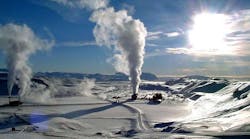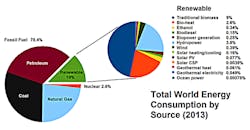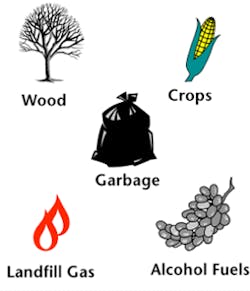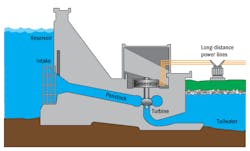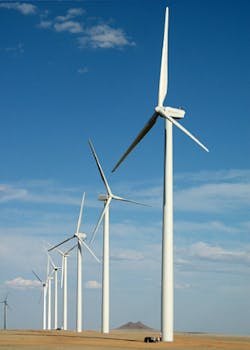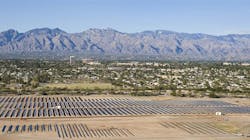Is Renewable Energy Ready to Topple Fossil Fuel’s Domination?
Download this article in PDF format.
It seems like, in the near future, renewable-energy source technologies such as solar and wind power have a chance to surpass traditional fossil fuels in terms of usage. I mention solar and wind power because these energy generators seem to be more visible than other types of renewable energy. Being born and bred in Arizona, I’m certain that solar energy sits at the top of the list. After all, it seems like almost every other week I see the occurrence of a new solar-panel installation, and there’s no shortage of annual sunshine in my neighborhood.
But, let’s step back and look at the big picture. According to the U.S. Energy Information Administration, renewable energy sources in 2017 collectively had a minor impact on the energy consumption in the United States (Fig. 1).
1. Renewable fuels, at below 5 quadrillion BTUs, collectively rank a little more than nuclear fuel. (U.S Energy Information Administration)
Fossil fuels such as petroleum, natural gas, and coal account for at least 80% of energy consumption in the United States. But, enough about this evil global-warming, climate-modifying fuel. For those that argue that natural gas isn’t a threat to global warming, they may be wrong. Natural gas emits less carbon dioxide than fossil fuels and coal to be sure. There’s a widespread effort to replace other fossil fuels with natural gas. The pitfall with this movement is that the by-product of methane or natural-gas combustion is water and carbon dioxide. Ouch.
Let’s concentrate on the future of renewable fuels (Fig. 2). Five renewable fuels are ahead of the pack in today’s energy creation and consumption landscape. The origin of these fuels is from biomass energy, hydropower, wind, solar, and geothermal.
2. A worldwide view of renewable fuel in 2013 highlights bioenergy at the front of the pack. (Credit: Wikipedia)
Biomass Energy
The most prevalent renewable energy today involves biomass. The production of biomass energy comes from recently living organic matter like plants. This is a nice renewable resource because plants can be quickly regrown, and a main source of energy for them is water, CO2, and solar.
I can remember that the craze a while ago was using biomass fuels to replace the petroleum fuels in cars or trucks. At that time, I had an image in my mind of a confused truck driver at a truck stop feeling like he was a cattle magnet. Gosh darn, that corn-based biomass fuel.
The creation of bioenergy comes from wood (largest biomass), miscanthus, switchgrass, hemp, corn, poplar, willow, sorghum, sugarcane, bamboo, eucalyptus, palm oil, etc. (Fig. 3). Biomass fuel’s contribution to carbon is somewhat of a wash. Harvesting and burning plants for energy produces carbon. However, the generation of new plants require time, water, and the consumption of carbon dioxide. I guess that’s what makes it a wash.
3. Plants and waste are natural biomass energy makers.
The good news is that we humans have a huge repository of wasted trash that often happens to be renewable organic waste. The origin of renewable natural gas (RNG), or biomethane, is from organic wastes that have a moisture content. Cities, towns, and businesses around the country already use RNG to manage local waste and power vehicle fleets. And one innovative company in Fair Oaks, Ind.—a dairy farm company—powers milk delivery trucks with cow manure RNG. On the plus side, this saves them $2.5 million in annual fuel costs, while at the same time reducing 24,000 tons of CO2 emissions.
California is at the forefront for passing a bill that targets 100% renewable energy by 2045. The claim is that this initiative bill creates new jobs and powers homes, businesses, and cars with clean, zero-carbon energy. The actual date may not be achievable; however, the state’s direction is clear.
Hydropower
Hydropower or water power has been an effective resource for humans since the beginning of time. Basically, this power comes from falling water. When harnessed, it takes on various energy-producing forms: watermills for irrigation, waterfalls for electricity, or stored water in dams—the water from a released dam flows as kinetic energy through turbines to produce electricity. This style of renewable energy generates 19% of electricity worldwide.1
4. With this dam, steeper drops generate more water power and thus energy.
Most hydroelectric power plants are located on a river at a high elevation, with a dam to hold back the water in a reservoir (Fig. 4). The water flows through a penstock pipe into the dam. It then pushes the turbine, which turns an electric generator.
Wind
An engineer can easily consider wind a form of solar energy. Differences of temperature at the Earth's surface, when lit by sunlight, creates an atmospheric movement. This is because the sun causes uneven heating and cooling events in the atmosphere. The sun owns part of the changing wind conditions as does the earth rotation and other topographical factors.
5. Wind turbines in Lamar, Colo. make up a 162-MW Colorado green wind farm. Each turbine produces 1.5 MW of electricity.
Extremely large fans or windmills, with turbines, convert the wind to electricity (Fig. 5). In this manner, wind can cut business or home electrical costs. Commercial-grade wind-powered generating systems presently meet the renewable-energy needs of many organizations. Single wind turbines generate electricity as a supplement to an organization’s existing electrical supply. When the wind blows, power generated by the system offsets the need for utility-supplied electricity. The electricity purchase of utility-scale wind farms is in the wholesale power market, either contractually or through a competitive bid process.
Solar
So now it’s time for me to come back to my hometown of Tucson, Ariz. The Davis-Monthan Air Force Base in Tucson has installed quite an array of solar panels (Fig. 6).
6. Solar panels on 170 acres of underutilized land collect sunlight energy. (Credit: U.S. Air Force /1st Lt. Sarah Ruckriegle)
"For a minimal investment in manpower, projects like this provide substantial savings," says Lt. Col. Brian Stumpe, the 355th Civil Engineer Squadron commander. “The Davis-Monthan engineers found that in the first 10 months of operation, the array produced 33,083,404 kWh of electricity, enough to power over 3,600 homes. This amounts to a $500,000 per year savings for Davis-Monthan and the Air Force."
Now, renewable-energy projects like the Davis-Monthan array are part of the Air Force's overall strategy to provide energy resiliency, reliability, and security, as well as cost savings. Power systems located on secure installations deliver necessary predictability, and dollar savings free up resources that can be reallocated to other mission priorities.
Geothermal Energy
Another form of alternative energy is geothermal electricity. Barring any property investment on Hawaii’s Big Island, this energy is usually sustainable and reliable. Magma conduits, hot springs, or hydrothermal areas provide Earth’s heat energy to spin turbines or heat buildings (Fig. 7).
7. The Krafla is a geothermal power station located in Iceland. (Credit: Wikipedia Commons/Ásgeir Eggertsson)
One drawback to geothermal energy is the limitations of location. Only a small number of places allow for the cheap harnessing of this energy. However, in certain areas of the world, such as Iceland, Indonesia, and other regions with high levels of geothermal activity, it’s an easily accessible and cost-effective way of reducing dependence on fossil fuels and coal to generate electricity.
Location, Location, Location
One problem with renewable energy is the limitations that ensue due to the dependence on nature. A secondary issue is the expense of alternate energy compared to traditional sources such as oil and natural gas. Until very recently, running coal-fired or oil-powered plants was cheaper than investing millions in the construction of large solar, wind, tidal, or geothermal operations. Ongoing improvements make solar cells, wind turbines, and other equipment viable energy competitors. All over the world, nations and communities are making efforts to hasten the evolution toward cleaner, more sustainable, and more self-sufficient methods.
Galloping into the Future
Are the days of coal and oil domination winding down? Some say yes, or at least Californians would say absolutely. There are several ways to generate power from biomass, hydro, wind, solar, and geothermal sources. These renewable-energy source alternatives to fossil fuels are already becoming an important part of our power-generation mix. So, what do the years in the future hold? Or a better question is: “When will the renewables dominate?”
Reference:
